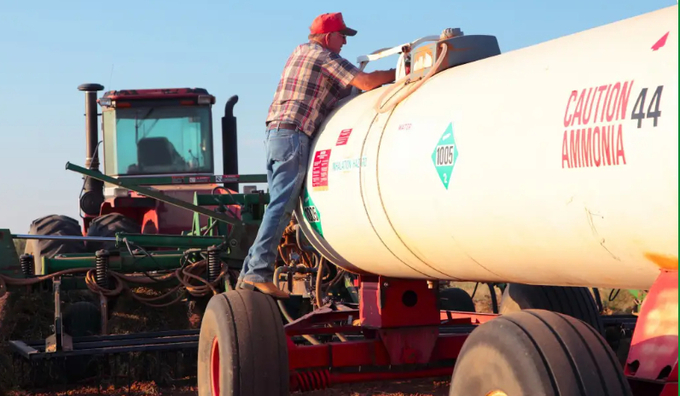November 27, 2025 | 18:31 GMT +7
November 27, 2025 | 18:31 GMT +7
Hotline: 0913.378.918
November 27, 2025 | 18:31 GMT +7
Hotline: 0913.378.918

The company starts by splitting water into hydrogen and oxygen molecules and separating nitrogen from the air. Then, it pumps hydrogen and nitrogen into a reaction chamber, where lithium helps attach the right number of hydrogens to each nitrogen atom. Ammonia emerges from the other side.
When Suzanne Zamany Andersen arranged her trip to greenhouse grower Koppert Cress in the Netherlands, she thought she would just be pitching her startup’s device, which turns electricity and air into ammonia, a widely used fertilizer.
Not only did the company agree to test the ammonia production system made by her company — Denmark-based NitroVolt — it also referred her to its relatively new investment arm, Division Q, which ended up making an investment.
Once installed, NitroVolt’s device will produce ammonia that Koppert Cress will use to grow its crops (a range of different cress varieties), and it’ll use heat generated by the device to warm its greenhouses. “This is a perfect fit,” Andersen said the company told her.
The majority of the world’s ammonia is produced using the 115-year-old Haber-Bosch process, which is heavily reliant on natural gas. For growers like Koppert Cress, which wants to eliminate its carbon emissions by 2026, fertilizer represents a challenging source of pollution to zero out.
NitroVolt is one of a fresh crop of startups working to find alternatives to Haber-Bosch. The company starts by splitting water into hydrogen and oxygen molecules and separating nitrogen from the air. Then, it pumps hydrogen and nitrogen into a reaction chamber, where lithium helps attach the right number of hydrogens to each nitrogen atom. Ammonia emerges from the other side.
Ammonia is one of two nitrogen-based fertilizers that are broadly used throughout agriculture. “Certain crops really like ammonia, certain crops really like nitrates,” Andersen told TechCrunch.
The first farmer likely to pilot NitroVolt’s system is a rapeseed farmer in Denmark. “He swears by ammonia,” Andersen said.
But Denmark doesn’t currently have any ammonia production, so the farmer’s brother drives to Poland several times per year to procure it. “When he saw that we could do on-farm production, he was like, when can you sell me this unit?” Andersen said.
Denmark isn’t the only place where ammonia is hard to come by. Much of Africa, South America, and even parts of Canada are ammonia deserts. “There’s places where the logistics and distribution costs of centrally produced fertilizer is just really high,” Andersen said. “These markets, they’re not served by the current incumbent technology. So this is where we can essentially step in.”
NitroVolt’s pilot unit will produce about 5 kilograms of ammonia per day, but the startup has plans to incrementally boost production to 150 kilograms per day, enough to supply a typical farm in Denmark and the U.S. The whole operation would fit inside a standard 20-foot shipping container.
The startup raised a €2.75 million seed round led by BackingMinds and EIFO, the Danish sovereign wealth fund, to help build the pilot and hire staff to make it happen. Breakthrough Energy Fellows, Division Q, EQT Foundation, and Satgana participated, and BackingMinds underwrote a €750,000 convertible loan.
Andersen said that, if farmers have renewable energy on site, NitroVolt’s system can produce ammonia at a cost comparable to what they pay today. As more farmers adopt renewable energy, that could help tip the balance in favor of electrically-produced ammonia.
“We first started with farmers three years ago, they really didn’t have a lot of renewable energy on site,” she said. “Over the past three years, more than half the farmers we talked to either have solar on site, despite the fact that it’s basically never sunny in Denmark, or they have bought big wind turbines. It’s really a shift that’s happening.”
(Techcrunch)

(VAN) According to Mr. Vo Minh Thanh, Director of the Tay Ninh Department of Agriculture and Environment, Resolution 57 has created a new development pathway for the locality, shifting from traditional toward modern agriculture.
/2025/11/26/4909-2-154329_878.jpg)
(VAN) Pearl grouper farming in HDPE cages not only delivers economic efficiency but also contributes to protecting the environment, creating jobs, and promoting marine-based experiential tourism.

(VAN) The model of making a living under the forest canopy through the agroforestry system in Van Son commune, Bac Ninh province, is expected to generate an annual income of approximately VND 30 million/ha.

(VAN) Many enterprises in Can Tho are harnessing natural energy and reducing greenhouse gas emissions in their production processes, thereby contributing to the promotion of a sustainable green transition.
/2025/11/24/3536-2-112800_176.jpg)
(VAN) Dong Nai now has tens of thousands of hectares of forests certified for sustainable management, and this area will continue to be expanded in the coming period.

(VAN) Vinh Ha hamlet (Dai Xuyen commune, Hanoi) is shifting away from small-scale farming as households adopt bioscurity into their breeder chicken models.

(VAN) Heavy rains make aquatic species more vulnerable to disease. Proactive water management and high-tech systems help farmers prevent outbreaks and protect yields.